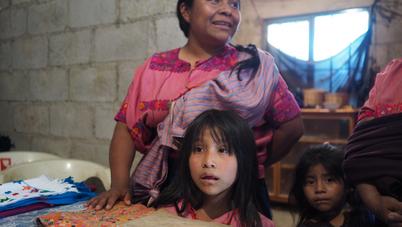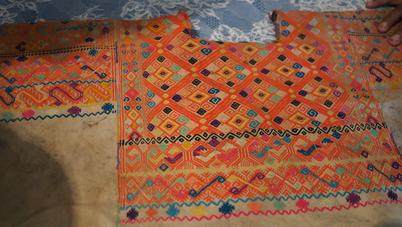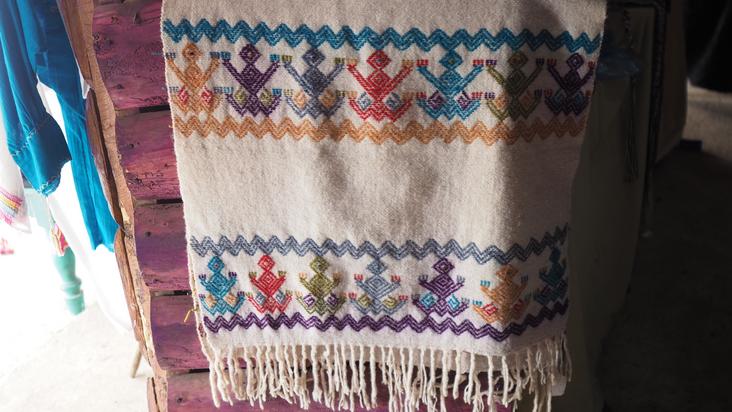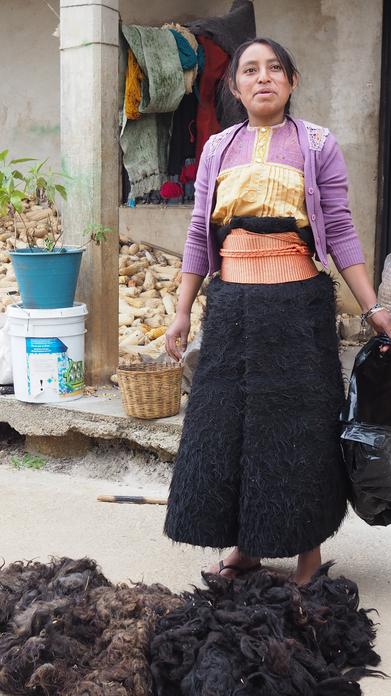Mayan mythology & textile art in Chiapas
The strong local identity in the villages of the Highlands of Chiapas is, amongst others, reflected in the women's huipiles where you from the design and colours can see which community the woman comes from.
Although not all weavers know the origin of the classic, woven patterns according to Chip Morris *4 a line can be drawn back to ancient Mayan patterns as they appear on stelaes in Mayan temples.
The patterns origins from Mayan mythology and their vision of the world and are an important part of the cultural heritage.
Ancient huipiles and the transmission of Mayan mythology
The families keep the old huipiles in order to copy the ancient Mayan patterns, thus ensuring survival despite the changes in fashion.
Here, for example in Magdalena, the women’s current fondness of light and purple shades is very different from the ancient huipiles.
The square pattern in the huipil with the many coloured fields is a stylised model of the universe with the four Cardinal Points and the orbits of the sun and the moon.


Mayan designs and mythology
With this beautiful reboso (see foto below), the weaver Petrona Patishtón won the 3rd prize at one of the state’s craft arts competitions where the most skilled weavers exhibit.
The work shows the traditional Mayan patterns of the Holy Toad, El Sapo and the Earth, La Tierra.
The patterns originate from Mayan myths, but the stories, according to Walther F. Morris, vary slightly from area to area.
In Chenalhó, the myth tells that a toad named Antonia is guarding the door to the house of the Lord of the Earth, while the toad in other versions is his wife. In myths from Zinacantán, the toad is the musician of the Lord of the Earth, while according to a shaman from Zinacantán it is the shaman of the Earth Lord.
Perhaps it’s no coincidence that the toad plays such a big part in mythology. A certain species of the toad that lives in the area, Jenjen in Tzotzil or Bufus marinus in Latin, emits a secretion from the glands with 20 different active substances. One of the drugs is 50 times stronger than cocaine, another is an active hallucinogen while other of the substances can be deadly. * 2


See more about Petrona's work in Petrona from Chamula
You can find out more about ancient designs in the video from Pantelhó, where the women have preserved a large number of Mayan patterns.
A textile artist in Chiapas
In the following chapters we visit some of the region's skillful weavers along with the textile artist Carlos Reyes. A textile artist in Chiapas
Carlos Reyes is from Mexico City and has lived abroad for several years, but has moved back home and is now in Chiapas to realise an art project.
He tells about his project and reflects on his experiences with the local weavers, where the collaboration has also been an encounter between two very different parts of Mexican culture: Carlos Reyes and his privileged middle-class background from the big city meeting with and the skillful weavers and their beautiful craftsmanship, but at times also an economically disadvantaged live in the rural districts of Mexico.
Vi follow him to Magdalena, San Juan Chamula and Pantelhó in Chiapas.
Más sobre... arte textil y ropa tradicional
Sna Jolobil
The cooperative Sna Jolobil in San Cristóbal de las Casas was founded by skilfull weavers from the region and displays the works of about 800 different weavers.
On their FB page you can see examples of different tecniques and pieces: Sna Jolobil
Designs and traditions in Oaxaca
See more about textile art in Oaxaca also. Check out Huipiles from Oaxaca or Weavers in Teotitlán del Valle.